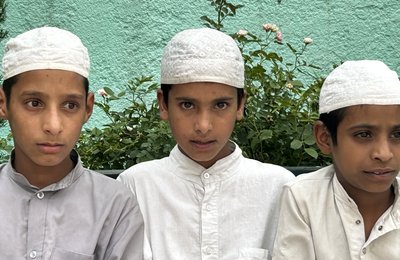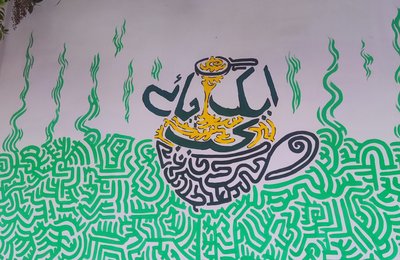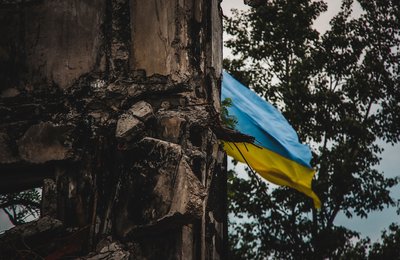Painting peace: Street art in Kyiv

The Revolution of Dignity in 2014, the occupation of Crimea and the conflict in the east of Ukraine sparked an explosion of street art influenced both by national politics and aspirations for peace.
“You can see the problems or major events in our society on the murals in Kyiv. What people think about is depicted in Kyiv’s walls”, Alyona Deriabina, a Street Art guide in Kyiv, told me.
“We want to live in peace, and get back our territories in the east and in Crimea. We dream about a peaceful united Ukraine”, she continued, referring to the conflict in the east of Ukraine and the occupation of Crimea that forced citizens to move across Ukraine to seek work and start a new life.
One of the distinguishing traits of the Kyiv murals are their colours; positive vibes and female portraits as symbols of peace and freedom. Threats, forms of violence, or symbols of war are all absent from the murals.
Here are six of the most striking murals we came across on our tour. You can watch more in our street art video.
More information on over 100 of Kyiv’s murals can be found at the Kyiv murals app.
A little citizen

The continuing reverberation of the occupation of Crimea informed the mural “A little citizen”. The piece was created by artist Kateryna Rudakova with support from the United Nations High Commissioner for Refugees (UNHCR). The creator of the mural was inspired by a small picture on Facebook of a little boy who was drawing a Ukrainian passport. Stateless persons do not have documents providing their nationality and they are often unable to enjoy basic human rights including education, healthcare, and employment.
The artist explained: “On the mural ‘A little citizen’ you can see a little girl with a Ukrainian passport. In the window you can also see a Swallow’s nest, a famous castle in Crimea. Because of the occupation, there is a big problem with citizenship, belonging and the rights of people living in the Crimea”. The integration of people displaced from the east of Ukraine and Crimea, as well as migrants to the local community has been a significant issue lately. During the tour, I noticed that the blue colour used to paint the Crimean sky and the sea is exactly the same as the Ukrainian flag, as a symbol that Crimea has to come back to Ukraine. What is also interesting, is that the little girl dreams of a passport. This small paper booklet means peace for her. In her eyes, the Ukrainian nationality symbolises peace.
The Berehynia

Another mural, “The Berehynia” (Protectress), depicts a female spirit – a goddess in Slavic mythology. Our street art guide told us she is “a Ukrainian woman that tries to protect our state to live in peace. She is surrounded by sunflowers, the national flower. The seeds symbolise a connection with the earth and also with the people who are not with us anymore”. This mural is located in a very powerful and symbolic site, Independence Square, where the 2014 Ukrainian Revolution of Dignity took place. This mural is personally one of my favourites with bright colours, delicate painting and shadows and the tender face of woman. It strikes with positive vibes and healing at the same time. Most of all, the picture is full of symbols, which are not immediately visible for those who don’t know them, like the yellow flowers, symbol of unity and Ukraine. The woman has her eyes closed, concentrating, and praying for peace, trying at the same time to spread over the message.
See this mural in our latest video
The Rebirth

On the corner of the Andriivskiy Descent and Borychiv Street, sits another mural: The Rebirth. It is hard to miss this mural in Podil, the heart of Kyiv. Every time I pass by the old streets in this area, I am amazed by the beauty and the size of the painting. The mural is always surrounded by tourists with cameras. It depicts a Ukrainian lady as a protector of the city. In her hand there is a little boy. She wears traditional Ukrainian flowers in her hair and dons the same military jacket that the protestors in Ukrainian’s Independence square wore. “It means that we are trying to reconstruct our city, live in peace, and that we believe in a better future. Unfortunately, after the war there was a lot of destruction. You can also see the blue sky that is a symbol of peace”. The Rebirth piece gives a strong message of a better tomorrow and how Ukraine can rebuild its cities after the conflict. It is very symbolic to see how the new buildings rise from the human mind.
I noticed that on the left of the mural there is a memorial to famous Ukrainian opera singer Vasyliy Slipak, who joined a volunteer corps to fight in the east of Ukraine and died in 2016 in the war. There is a project to rename this square after Slipak, as an homage to all the heroes who fought for freedom and peace.
Fragments of hope

“Fragments of hope” was created by Sergey Ratkovich as part of the Art United Us project set up in response to the conflict in the east of Ukraine in 2014. It brought together over 200 artists with the aim of undertaking peacebuilding in the community. The hands are a copy of Motherland monument, which is a symbol of Kyiv. “The mural shows hands, breaking the sword as a symbol of stopping the war and violence as well as bringing peace in the community”, Deriabina told us. The monument is a protectress of Kyiv and Ukraine. By breaking her sword, she denounces violence and expresses her wish for weapons to be put down.
Shelter

The mural “Shelter” takes up two walls and depicts a woman in monochrome. Our guide tells us that you need to be in the right spot to see the whole painting. This piece could be read as a representation of the Internally Displaced Persons (IDPs) from Crimea and the non-government controlled areas in the east of the country seeking home and shelter in Kyiv. The mural symbolises a small place where IDPs and host community can live together in peace. The displaced people are running away from their home because of conflict and war, and this woman is welcoming them with warmth and open arms, providing them with a home.
Freedom

On Ivana Franka Street, one of the most famous street murals depicts an upside-down bird with a bulb in its claws. It holds the bulb around the window. The famous Ukrainian artist Alex Maksimov called the mural “Freedom”. “The window on the wall is surrounded by the glass bulb, a kind of a border between people inside the bulb and the world, or between a human and peace”, the artist told us. “To change something, you just need to break the glass and be free”. The mural was also created as a part of the Art United Us project. It is a Ukrainian-led international project that – through artistic and creative mediums – collaborated with communities to raise public awareness and attention to the problems of war, aggression and violence. Some 200 walls were painted over two years.
The mural speaks to the local community every day. “When I saw this mural in my neighbourhood, I was really impressed. It reminds me of challenging times which we are living in and also the ongoing conflict. Every day when I pass it on the way to the metro, I’m thinking about the conflict that we have to live through”, a local resident told us.
Take the tour yourself by watching our new video
The making of murals
We asked the artist behind the bird mural, Alex Maksimov, how these pieces of art are having an impact: “The art is changing the world in a good way. It brings positive emotions to people. In general, all art contributes to peacebuilding as art changes people. Very often some unusual things around can attract people’s attention, for example, an upside-down bird with a bulb to provoke an interest to read more about the mural and the messages behind it”. Colours, words or the subject in the mural can make people stop for a second to look. That way, the artist’s idea and the messages for the local community are shared.
In some cases, though, the paintings are not self-explanatory and require an additional explanation to avoid sparking conflict in the local community instead of working towards peace. Written explanations online or on social media, or better still, involving the community in painting the mural, help to increase people’s understanding of the art’s intentions and message.
When making a mural, it is about what story the local community would like the wall to tell. Each drawing carries with it special stories, and can be a strong symbol for people.
Yan Ptushko, a muralist from Donetsk, shares how he does this: “First of all, I develop the sketch of the mural with local activists that invite me to draw a mural. Then, I explore the area and the wall to make sure the mural would be well located and aligned with the message. Normally, when I create a mural in schools in the east of Ukraine, I conduct masterclasses to improve communication between students, parents and school administration. I leave about a metre from the ground unfinished, so we can draw a part of the mural together. This activity promotes social cohesion in the community, positive communication, dialogue and also evokes emotions to change the world.”
Storytelling and reconciliation
At first glance it may seem surprising to see murals as a potential instrument of peace and reconciliation. Maybe because it is hard to measure the effect of the murals instantly on changes in behaviour, and because you touch or feel it directly.
However, globally we see that the way murals talk to people takes place over the long term: changing behaviours, mindsets and values. Listening to each other’s stories through murals is an indispensable step in fostering mutual understanding and reconciliation. It can act as a peacebuilding activity in itself, as well as setting the stage for other activities with the same goals.

If more support can be given to sharing, deciphering and discussing these large pieces of art, then peace, social cohesion and community engagement would only increase. Therefore, street art needs communication and financial support from educational and cultural institutions, well as art associations and community groups. In addition, leaders should promote the work of street artists to draw attention to issues of peace and promote the role of community members as agents of change. To make the peacebuilding impact reach more broadly into the community, murals should be complemented by training, events and social media campaigns. Sometimes, the most effective peacebuilding action is undertaking creative and innovative projects that no one expects to last, which can have ripple effects of lasting change.






